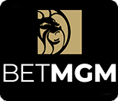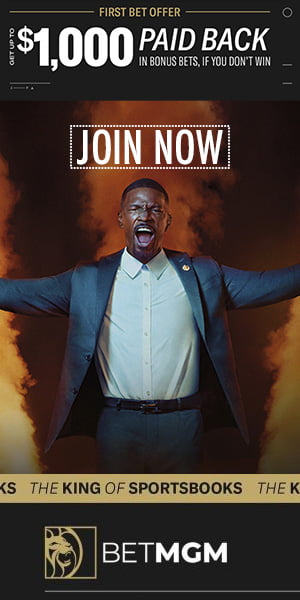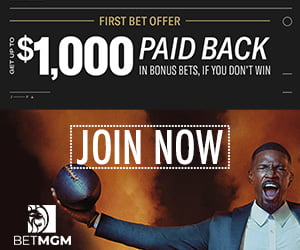NFL Betting
NFL Betting Fundamentals
The bottom line with NFL betting odds is the spread (including the moneyline) and the total. These are the most important aspects for both expert and novice bettors.
Betting The NFL Spread
The point spread denotes the number that must be covered by the favorite in order to be considered a winner, or be beaten by an underdog for the same result. These NFL betting lines are set by oddsmakers in the hopes of getting equal action on both teams, giving the bettor an almost even chance of winning a wager, even if one team is clearly superior. In a spread, a minus sign before a team’s name shows their status as favorites, while a plus sign indicates that they’re the underdogs. Take the below example:
Team A: +4.5

100% Bonus up to $1,000 + $25 Token
T&C APPLY | NJ, MI ONLY Join Now
100% Bonus up to $1,000 + $25 Token
T&C APPLY | PA ONLY Join Now
$1000 Risk Free Bet
T&C APPLY | NJ, PA, IN, CO, NJ, MI, IA, LA, MS, OH ONLY Join NowTeam B: -4.5
Here, Team B is the favorite, and will need to win by five points or more to cover the spread. While if you were to bet on Team A as the underdog, they must either win, or lose by less than five points, for your bet to come through. However, if the spread is a round number, and this is matched by the teams, then your bet would have pushed (tied) and your wager will simply be refunded.
If you don’t want to worry about the spread, then a simple bet on who will win might be more up your street. This is known as betting on the moneyline, and many bettors consider the strength of NFL betting odds to back the strength of the spread. The moneyline is predicated on multiples of $100, so if a team is -200 on the moneyline, then you will need to bet $200 to win $100. Likewise, if the “comeback” on that money line is +145, you would bet $100 to win $145 if you took the underdog. As with the spread, the favorite always has a negative moneyline, and the underdog a positive moneyline. So, if we go back to our example of Team A and Team B, where Team B is the favorite, here is what the moneyline might look like:
Team A: +145
Team B: -200

100% Bonus up to $1,000 + $25 Token
T&C APPLY | NJ, MI ONLY Join Now
100% Bonus up to $1,000 + $25 Token
T&C APPLY | PA ONLY Join Now
$1000 Risk Free Bet
T&C APPLY | NJ, PA, IN, CO, NJ, MI, IA, LA, MS, OH ONLY Join NowThis ultimately means that, because you are not given points, the team you think will be victorious would have to win outright.
NFL Betting The Total
The total might be the simplest form of NFL betting. Looking at our Team A and Team B example again, the total offered on the game could be 38, which is the combined score of both teams. Your options are to bet over or under that same total score — if you bet over the total and the game finished 21-19, you would win your wager.
The total is generally not an even number, however, and the “hook” would probably be 38.5. And let me say, gentlefolk, that half point can become a real problem. On the off-chance that the total number remains even, you could push the bet (essentially a draw between the bettor and the sportsbook) and have your money refunded, though this is rare.
How the Vig Affects the Line
The vig, (also known as the vigorish or the “juice”), is the amount bookmakers will charge in return for processing your bet. Theoretically, this “commission” is 10%, but that is rarely the case in practice. Say a bookmaker has 100 players, and wants 50 to bet on Team A and 50 on Team B, he would make that 10% commission. In reality, bookmakers tend to earn between five and eight percent.

100% Bonus up to $1,000 + $25 Token
T&C APPLY | NJ, MI ONLY Join Now
100% Bonus up to $1,000 + $25 Token
T&C APPLY | PA ONLY Join Now
$1000 Risk Free Bet
T&C APPLY | NJ, PA, IN, CO, NJ, MI, IA, LA, MS, OH ONLY Join NowThe thing many people don’t understand about betting on sports is that it’s just like investing in the stock market. Of course, you can “gamble” on it, but to make a living doing it, you must be diligent in terms of knowledge and prowess. Herein lies the reason bookmakers will move the juice before they move the line. That is, in a Team A versus Team B scenario, where B is -4, there might be a slant toward Team B. Instead of moving the line, the bookmaker would probably move the juice to entice more players to bet Team A.
With football bets that use a standard 20-cent line, Team A is -110 and so is Team B. If you know anything about integers then it is apparent the disparity is 20 cents. Therefore, the bookmaker might move the juice on Team A down to -105 or possibly to even money at +100. In even rarer instances, the juice might be moved to +105 — meaning you need to lay down $100 to get $105. Thus, Team B would simultaneously become the more expensive bet.
If Team A drops to -105, then Team B becomes -115 and so on, until Team A is +105, making Team B an extremely expensive 125. That doesn’t sound too bad if you’re only betting a dollar ($100) where it would be $125 to get $100. However, if you’re betting a dime ($1,000) or ten dimes ($10,000), then it becomes almost bad business, unless you are relatively sure you have a lock (a sure thing). But of course, there are never sure things with NFL betting.
How to bet on a NFL football game
There are several ways to do NFL betting, and they hold true for spreads, moneylines or totals. The key is to place your bet at the accepted time.
- Before kick-off, you can bet the game/total, the first half and the first quarter.
- You can place any bet on any given quarter just before it starts.
- During halftime, you can bet the second half line/total.
The last part of betting on a NFL game is where it gets fast, hard and potentially expensive: live betting. This type of wagering moves at an exponential pace, and is always evolving. For example, if Team A, the underdog, scores a touchdown or even intercepts a pass two minutes into the second quarter, everything restarts from zero, but at a price. So if Team B was -4 at the start of the game, depending on the exact time remaining and the underlying action (touchdown, field goal, interception, etc.), the new “current” spread might be Team B +1; -125.
Exotic NFL Betting
The bets we have been discussing are “straight” bets — exotics are just variations on these. Three popular examples are parlays, teasers and if-bets.
NFL Parlays Betting
Parlays are the most common exotic bet, because they’re the easiest to understand. They are a combination of straights which must contain at least two plays. A two-team parlay pays 2.6:1; three-team parlays pay 4:1; four-team parlay gives 10:1 and so on. Bettors rarely extend beyond a four-team parlay because of the downside — that is, any loss causes the whole bet to be a loser. Any push reverts the parlay to the lower number team. If you have Team A, Team C, Team E and Team G in a four-team parlay at 10:1, a $100 play pays $1,000. If any of those teams lose, you lose. If one team ties, then it reverts to a three-team parlay, bringing your payoff to 4:1, and losing you $600.
Teasers
This is a form of sports parlay that enables you to adjust the points spread to your liking in return for a lower potential payout. The upside of teasers is that you can bet on every side of a single game, as you will be given points above the actual spread.
The bottom tier teaser is six-points, so for a Team A/Team B scenario with Team B being -4, a six-point would move the spread to Team B +2. You could also bet all four sides of this game: so Team B +2; Team A +10 and the original two sides. The original total is 38, so taking the over with a six-point teaser drops it to 32, while taking the under makes it 44. The payouts look like this:
- Two-Team Teaser: 10:11
- Three-Team Teaser: 9:5
- Four-Team Teaser: 3:1
- Five-Team Teaser: 9:2
- Six-Team Teaser: 6:1
- Seven-Team Teaser: 10:1
- Eight-Team Teaser: 15:1
- Nine-Team Teaser: 20:
- Ten-Team Teaser: 25:1
If-Bets
The third type of exotic NFL wager is an if-bet, which is a conditional action that hedges the position — that is, you bet on two or more teams in whatever order. If the first team in your betting list loses, then your bet stops — just like losing one bet. Yet, if you win one bet, the next in the sequence is automatically placed. Win all of them and you have won multiple bets with the risk of only having one on the table. If-bets are similar to parlays but, rather than accumulating odds with the money you win on one bet being placed on the next, you instead place equal bets on several teams.
The kissing cousin to the if-bet is the reverse wager, which consists of multiple overlapping if-bets. Say you placed two if-bets with one team as the first selection in one bet and second in the other, and vice versa, you would (almost) be guaranteed for one of these selections to come through. As such, many people decide to play longer reverse bets to increase their possibility of winning, though this does mean their stakes will increase exponentially too.
The Three Focus Points of NFL Betting
NFL betting revolves around three major factors: spread, location and injury reports.
Spread
The spread is the obvious concentration because it gives insight into where the market is moving. Spreads differ wildly between college and pro. A college line might be -40, but a pro line rarely goes above -14. The same holds true for totals — a college total might easily be 75, but a pro total is very rarely more than 45.
Location
As touched upon, the home team in the pros generally gives up three points in the spread. Yet a “home dog” — the home team as the underdog — will entice bettors to at least consider the situation further, as the football betting environment will be more attractive. Again, the difference between pro and college can be vast. A home dog in the pros might be +3, but a college home dog could be +10 or greater.
Injury Reports
No single player makes a team, but injuries to key players can affect the spread and the total of any game whether college or pro. For instance, if a star running back or, God forbid, the quarterback is injured, NFL betting lines and totals will go askew. The other side of that is if a major defensive player gets injured and therefore, unlikely to play, it could be the same difference. As a result, checking injury reports before NFL betting is vital.
A Short NFL Betting Glossary: You Can Be a Novice but Need Not Sound Like One
- Action: All bets made on football are called its action. For instance, if you wager $10 on the Dallas Cowboys to cover their 6.5-point spread as favorites against the 49ers, the bet would be referred to as part of the action. If a sportsbook is “taking a lot of action” on the 49ers, it means most bets coming in are on them.
- Bad beat: Losing a wager you should have won, especially when the result is determined late in the game. So in the NFL, this could happen after a last second touchdown or field goal.
- Backdoor cover: When a team scores at the end of a game to unexpectedly cover the spread.
- Chalk: Quite simply, the favorite in a game. Someone who regularly bets on the favorites can also be referred to as a ‘chalk’ bettor.
- Home or Away: This is a visual. The team that is at the bottom is the home team. In our Team A versus Team B scenario, Team B is the home team. And, a home spread in the pros is usually -3. This denotes the teams are more or less even but because Team B is at home, they will give three.
- Longshot: A team deemed extremely unlikely to win, otherwise known as an underdog. In the NFL, teams like the Jacksonville Jaguars and Oakland Raiders are often seen as longshots to win the Super Bowl as most don’t believe they have the quality to triumph.
- Money: This is purely slang but it’s universal. Starting from the bottom, a “small” nickel is $50. A dollar is $100. A nickel is $500. A dime is $1000. You absolutely must be specific about this because you don’t want to bet a nickel when you really meant a small nickel. A NFL betting bookmaker will gouge you on your own mistake, so don’t make it.
- Pick’em: A pick’em is basically an even call on the winner whether home or away.
- Price or number: Either term refers to what the spread is, or what someone got while betting the game. Price usually denotes what the juice was, but these terms go hand in hand. Hence, in an ordinary game with a 20-cent line per usual, you risk $110 to get $100. About the best you can hope for is to get the number at even money which would mean laying $100 to get $100 and still getting 4 points. This is how the price and the number are connected when betting the spread.
- Push: This is where the result lands on the betting number, meaning any wagered money is refunded. A push typically happens when the final score of a game doesn’t favour either team in the spread, such as if a 3-point favorite wins by exactly three points.
- Shorthand: If the juice on Team A had been moved to even money just before kickoff, my pad would read: A, $1, EV. Team A for $100, even money — betting $100 to get back the same. No juice in this instance. That’s how I would write it for my own records.







